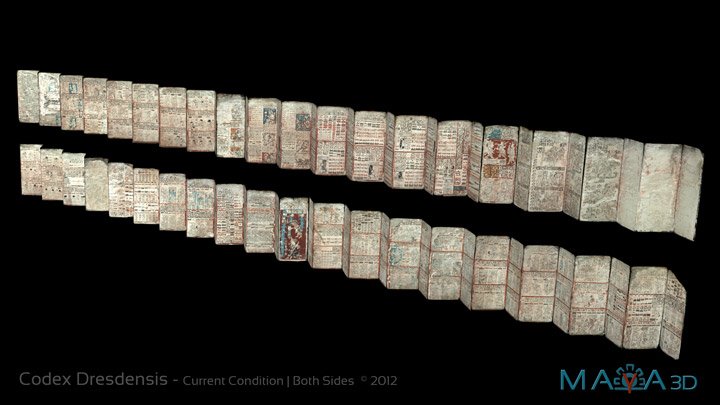Codex Dresdensis
The Codex itself consists of 39 double-sided written, originally as Leporello folded leaves of fig tree bark, which are exhibited in two strips with a total length of 3.56 m between glass plates in the treasury of the library in Dresden, Germany. It shows hieroglyphs, images and symbols, describing diseases, harvest times, religious acts and sacrifices. It also contains various astronomy almanacs, calendars, astronomical tables, ritual regulations and numerous representations of gods.
In addition to the other Mayan writings in Madrid, Paris and Mexico City, the Dresdner document contains an apocalyptic picture depicting a deluge accompanied by mythical dragon figure. The Dresden librarian Ernst Wilhelm Förstemann was able to decipher the calendric part of the codex at the end of the of the 19th Century. Moreover the complete work is considered a key document for the decipherment of Maya hieroglyphs, and for the study of astronomy, cosmology and chronology of the Maya.
Our reconstruction work was focused on merging the 78 pages of the current Codex (after World War II), the Förstemann Edition (1884) and the Kingsborough Replicat (1826). Later we superimposed all editions as exactly as possible. Next step was the adjustment of colors of the Kingsborough-Edition and the re-drawing of the red-brown borders with a slight worn and round look, as well as the addition of paper structure. Then we cleaned up the lime-particles around the pages of the current edition and transfered everything to textures with transparency and bump.
Next step was the modeling and texture-mapping of the 39 sheets and the animation of their leporello-folding.
After lighting the scene we started the blending of 2 Editions.


Feel free to contact us for a copy of rendered codex-animations or even the 3d model including the accurate HiRes-textures of the current condition, the 125 years old Förstemann-Edition and the Kingsborough-replicat.
